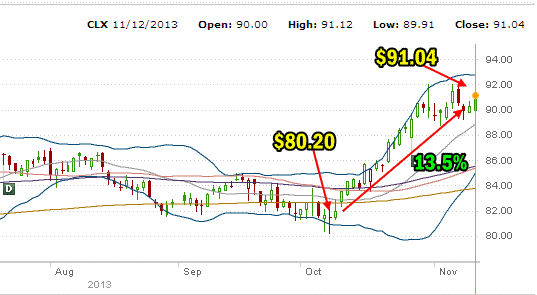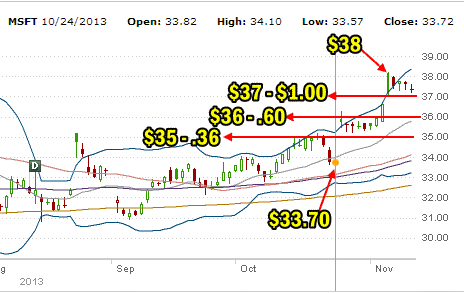The market direction seems to perplex a lot of investors over the past couple of weeks. Starting in September the market direction commenced a correction which over a period of two and half weeks of trading resulted in a 4.8% correction. Throughout all of 2013 the corrections have been few and shallow. The September correction was typical. By Oct 9 the selling bottomed and the market commenced a strong rally on the belief that the Federal Reserve would not commence scaling back Quantitative Easing most likely until 2014 plus the debt ceiling fiasco ended with an extension into early 2014. The rally back resulted in a 7.8% move higher and on October 30 the S&P hit a new all time high of 1775.22.
Since then the market direction has turned decidedly sideways. First it was understandable as the market worked out the overbought condition. The consolidating process lasted about a week but then stocks stayed sideways. You can see all of this action in the chart below. Many investors are perplexed by the market direction staying sideways and failing to fall back or push higher. A lot of the reason for the market direction not falling is being caused by year-end window dressing by fund managers.

The recent market direction action has perplexed many investors
What Year-End Window Dressing Is All About
2013 has been a terrific year for stocks. If an investor had bought an index fund at the start of January and was still holding it today he would be up 23 %. However many of the returns from mutual funds, hedge funds and institutional funds are poor by comparison. Indeed many are up barely 10%.
Many fund managers jumped out of stocks before September believing that the Fed would begin tapering and stocks would tank. This did not happen and they have been caught missing the rally that followed.
Many have had to jump back in and are trying to boost their end of year returns to show a decent return that might come at least close to the S&P 500 total return. This is known as the year-end window dressing as fund managers of all types try desperately to boost their annual return. This year-end window dressing happens in most years but it is very noticeable in a year like 2013 when the index itself has posted gains of over 20%.
Fund managers know that the majority of clients do not review their statements until the year-end results are released. They also know that two-thirds of clients will jump out of their fund for a different fund that has had better performance.
For fund managers to jump in since the October rally commenced means picking up stocks that have good momentum to the upside. Most fund managers are not picking stocks for any period of time. They are not going long on these stocks but instead are picking up stocks that have momentum to the upside and are pushing them higher. This means daily dips are being used to pick up stocks and trade them. This also means stocks like Priceline, Federal Express and Microsoft to name just three out of hundreds are being snapped up on any weakness and pushed higher. These fund managers move from stock to stock trying to pick up 2 and 3 percent here and there to help boost the overall return.
Stocks With Strong Momentum
Federal Express Stock (FDX)
If we look at stocks like Federal Express (FDX) the move is obvious. The result of the two Fed announcements this fall can be seen in the stock’s price movements. Now up 23% since Sept 9 the number of shares available makes this an easy choice for year-end window dressing and momentum to the upside helps fund managers boost their year-end gains.

Procter and Gamble Stock (PG)
The other stocks fund managers look for are decent names with big floats that have been pushed lower. They jump into these stocks and turn them around. Procter and Gamble stock (PG) is a good example. Moving stocks like this are easy for a fund manager. Fund managers need stocks they can dump a lot of capital into and push higher and take profits all the way up. This can improve the overall annual return by easily 2 or 3 percent. If a fund manager is sitting with a return of just 10% for the year, three more points brings in 13% in a very short period.

Clorox Stock (CLX)
Big name stocks are often good choices as they already have a following and can easily be pushed higher. Clorox Stock for example had a recent downgrade by analysts which pushed the stock back to $80.20. Since then the stock has shot higher gaining 13.5% in just over a month.

These are just three examples of what is happening at present in stocks. Any drop in a stock is being bought and the stock pushed back up. By the time the end of the year rolls in, many of these funds can increase their returns anywhere from 3% to 6% and still get out of the stock by the end of the year.
If you look at the stocks in the above charts you can see that the movement sideways is a great opportunity for fund managers to unload their shares and dips in the stock here and there can be snapped up in smaller quantities and stocks again unloaded for smaller gains.
By keeping momentum up fund managers are able to play this game for a few more weeks. Therefore any downturn in stocks at this point then will play right into their year-end window dressing game. This is why I believe any downturn at this point will be shallow and short as a pullback of even 3% would be seen as an opportunity to jump back in and try to gain another 2% for the year-end.
Profiting Through Put Selling Momentum
For those of us who like to sell puts and do other option strategies this year-end window dressing can be highly profitable. The key is to stay far enough of the money with our puts and close them early or in the case of a stock that suddenly moves lower, be prepared to roll down naked puts for more profit. It is important to understand that this is year-end window dressing and nothing more. Most of these stocks will not be held by the fund managers. This is a year-end push to improve the annual returns for the yearly reports which investors will be reviewing in January and February 2014.
With that knowledge, we can easily sell puts against these stocks by picking those with momentum to the upside.
Microsoft Stock Year-End Put Selling
For example Microsoft Stock recently had a nice push to the upside. from a $33.70 on Oct 24 to a high recently of $38, this represents a 12.7% gain. With Microsoft Stock now trending sideways the put values have moved higher. I have shown the put values for Dec 21 options expiry. The likelihood of the stock falling much further is not great with the stock float the size of Microsoft’s. Instead fund managers will be picking up shares in small quantities at present on any weakness and should shortly push the stock higher. Any downturn in the overall market direction (per my market direction outlook) will of course hit Microsoft stock as well but it will allow fund managers to pick up shares at even better prices for a year-end push in which they will unload their shares.
For Put Selling Microsoft Stock the strategy is simply spreading out capital among 3 different put strikes with more capital at lower put strikes and less at higher ones and all of them out of the money.
After I have sold all 3 put strikes it is a matter of watching for opportunities to buy back sold naked puts for profits and close them before the fund managers start to unload their shares in larger volumes. You can tell when they are leaving a stock as the stock will face selling pressure but not fall by much. Increased volume to the downside without much drop in the stock is a good signal to watch for. You can tell when large fund managers are out of stock as it will fall further and faster on less volume.

Doing My Own Year-End Window Dressing
By picking solid companies such as Microsoft Stock to try to do a little year-end window dressing of my own, I know that if I am wrong and the stock falls too far, I can roll down my put strikes one after the other if the stock should fall. I know that the key to success in year-end window dressing is to buy back these naked put early and not wait for Dec 21 options expiration.
I am looking for just a bit more profit and taking advantage of the bigger investors and following the stocks they are trading in. That would include stocks mentioned in this article plus dozens more. This final bit of Put Selling to end the year is simple to implement especially when I am picking stocks that show every sign of momentum being in play and large volumes being traded.
It’s a nice way to end the year with a bit of a boost in my earnings, all thanks to year-end window dressing by fund managers who have to do whatever they can to boost their annual return.

